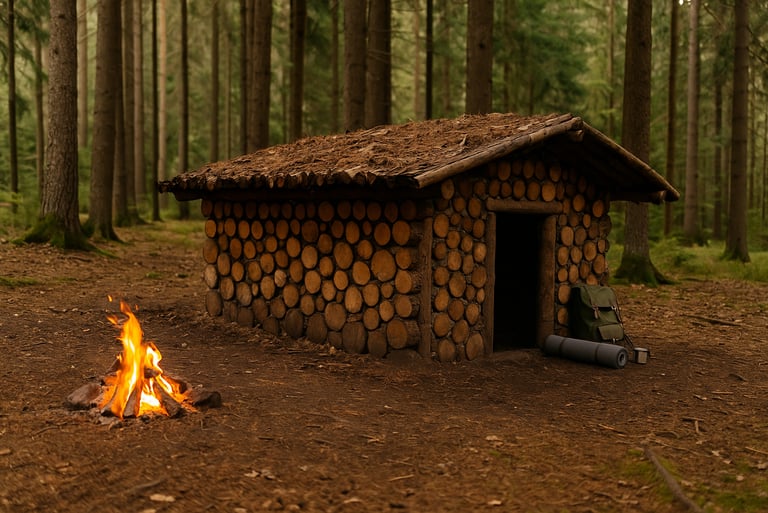How to Build a Cordwood Shelter: A Durable and Natural Survival Shelter
Learn how to build a cordwood shelter using natural materials like logs and clay. This guide walks you through step-by-step construction for a durable, insulated, off-grid survival shelter in the wild.


How to Build a Cordwood Shelter: A Durable and Natural Survival Shelter
If you're looking for a shelter that’s sturdy, well-insulated, and made from materials you can often find in the wild, a cordwood shelter is one of the best options. Though it takes more effort than a tarp or lean-to, a cordwood shelter can offer long-term protection from the elements and is ideal for those who want a more permanent or semi-permanent solution in survival situations.
Let’s walk through how to build one, what materials you’ll need, and why this type of shelter could be a game changer for your wilderness survival skills.
What Is a Cordwood Shelter and Why Use It?
A cordwood shelter is built using short lengths of wood (typically logs or branches cut to about 12–18 inches long) stacked and packed with some form of insulation between them. It’s a technique used in off-grid and natural building communities, but it also has great application for wilderness survival if you’re staying put for a while.
This type of shelter is particularly valuable because it offers thick, insulated walls that protect against cold temperatures, wind, and even rain. It also makes use of abundant natural materials, especially if you’re in a wooded area.
If you're planning to stay in one place for a while, a cordwood shelter offers far more durability than temporary setups like a poncho shelter for quick rain protection or a bivy shelter for emergency overnight use. While those are excellent for fast situations, cordwood is ideal for colder climates or semi-permanent survival bases.
Gathering the Right Materials in the Wild
To build a cordwood shelter, you’ll need a good supply of wood, specifically dry logs or thick branches cut into short, even sections. Aim for pieces around the same length so the walls are stable and uniform.
You’ll also need something to bind the logs together. In a wilderness setting, you can use mud, clay, moss, or even grass mixed with water as a natural mortar. If you have access to tools like a saw or hatchet, gathering and shaping materials becomes much easier.
Optional extras like a tarp or emergency blanket can be helpful for waterproofing the roof or insulating the inside once it’s built.
Step-by-Step: Building Your Cordwood Shelter
Start by choosing a location that’s elevated, flat, and protected from wind. Build a solid base, either by digging a shallow trench for the walls to sit in or laying logs directly on the ground in a circular or square pattern.
As you stack the cordwood, apply your chosen binding material between each layer to hold it in place. Keep the stacks level and fill any large gaps to avoid drafts. Build the walls up to shoulder or head height, depending on how much wood you have and how much insulation you need.
For the roof, you can lay longer branches or logs across the top and cover them with bark, grass, a tarp, or even a thatch of leaves to keep water out. A-frame or sloped designs help rain run off and are more stable in bad weather.
Inside, make a simple raised sleeping platform with more logs, or cover the floor with pine needles or grass for insulation.
To boost interior comfort, consider building a bough bed shelter inside your structure to insulate your body from the cold ground. You can also combine the design with elements from a debris hut to seal gaps and increase warmth retention.
How to Keep It Safe, Dry, and Warm
Cordwood walls provide excellent insulation, but you still need to protect your shelter from water. Make sure your roof is secure and has a slope. If possible, dig small drainage ditches around the outside to keep rain from pooling near the walls.
For warmth, a small fire pit placed outside the entrance can help radiate heat inward without the risk of smoke build-up. Reflective surfaces like a space blanket hung on the back wall can help bounce heat around inside.
Avoid building your shelter too large, smaller shelters retain heat more effectively.
When to Use This Shelter Type in a Survival Situation
A cordwood shelter isn’t something you’d build in a rush — it takes time, effort, and the right materials. But if you’re planning to stay in a location for more than a day or two, it’s one of the most durable and weather resistant options available.
It’s especially useful in colder climates where insulation is a priority, or when you want a semi-permanent base camp. For homesteaders, bushcrafters, or preppers, this shelter also makes an excellent practice project for building with natural materials.


© 2025. All rights reserved About | Privacy Policy | Terms and Conditions | Affiliate Disclosure | Disclaimer


